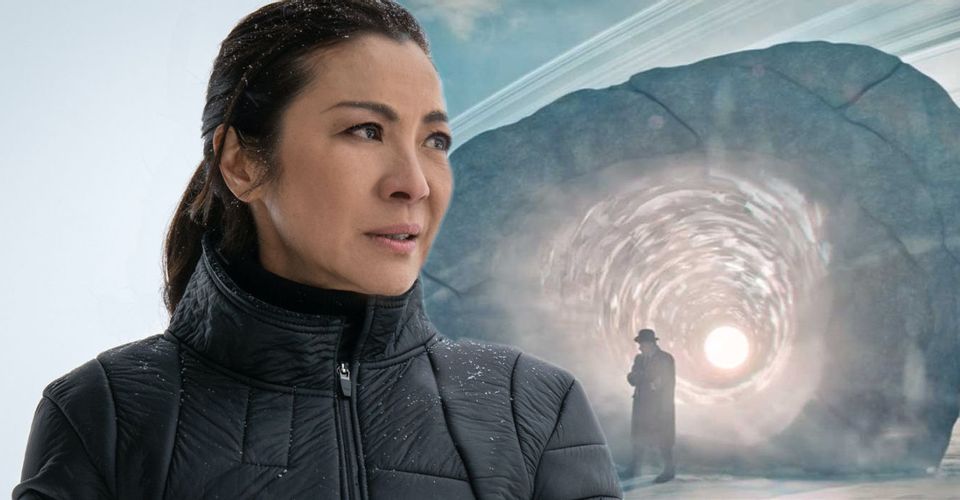Star Trek: Discovery Retcons How TOS’ Guardian of Forever Works

Warning: SPOILERS for Star Trek: Discovery season 3, episode 10, “Terra Firma, Part 2”.
Star Trek: Discovery reintroduced the Guardian of Forever from Star Trek: The Original Series, retconning how the space-time portal works and what it can do. The Guardian of Forever’s lone, live-action canonical appearance was in “The City on the Edge of Forever”, which is generally considered to be the greatest Star Trek TOS episode. The Guardian also appeared in an episode of Star Trek: The Animated Series but the concept was dormant for decades until Star Trek: Discovery shockingly brought the Guardian into the 32nd century under the guise of Carl (Paul Guilfoyle).
In “The City on the Edge of Forever”, the Starship Enterprise made first contact with the Guardian of Forever after it investigated mysterious ripples in time from millions of miles away. The away team led by Captain James T. Kirk (William Shatner) and Mr. Spock (Leonard Nimoy) encountered the ancient, irregularly-donut-shaped construct that introduced itself as the Guardian of Forever. Claiming that it was “my own beginning… and my own end” and that it existed “before your sun burned hot in space and before your race was born”, the Guardian showed the Starfleet Officers visions of the Earth’s past. Kirk and Spock then had to enter the Guardian’s portal to stop Dr. Leonard McCoy (DeForrest Kelley) from changing Earth’s history; the time portal brought Captain and the Vulcan to 1930s New York City, and they had to prevent a time paradox McCoy would cause if a woman named Edith Keeler (Joan Collins) lived when she was destined to die.
Star Trek: Discovery played an intriguing guessing game when Carl appeared on the planet Dannus Five, offering to help the dying Emperor Philippa Georgiou (Michelle Yeoh) by inviting her to pass through a doorway into the Mirror Universe. Carl, who appeared as a human and behaved in a jovial manner, gave off the impression that he might be a member of the Q Continuum from Star Trek: The Next Generation. But there were definitely clues that Carl was then Guardian of Forever; for instance, he stood in front of a doorway, which was a disguise for its massive stone time portal. Further, Carl made a point of showing off his newspaper, the Star Dispatch, which was the same publication the Guardian showed Kirk and Spock to explain who Edith Keeler was. When Carl revealed his true identity as the Guardian, he explained that he’s been in hiding ever since different factions fighting the Temporal Wars tried to weaponize the Guardian of Forever.

Star Trek: Discovery‘s version of the Guardian of Forever is radically different from how it was introduced in TOS, however, and Carl seems to contradict the very specific limitations of the time portal. After the crazed McCoy, who was accidentally infected with an overdose of cordrazine, jumped through the portal, Captain Kirk asked the Guardian if it could change the rate of speed that it was showing Earth’s past. The Guardian matter-of-factly replied, “I was made to offer the past in this manner. I cannot change.” But Carl is proof that the Guardian of Forever changed significantly.
“Terra Firma, Parts 1 and 2” also retcons the Guardian of Forever’s abilities. By sending Georgiou back to the 23rd-century Mirror Universe, the Guardian of Forever now has powers over not just time but across parallel universes. Plus Georgiou seemingly changed the Mirror Universe’s history or perhaps created an alternate timeline within the Mirror Universe, whereas Kirk and Spock merely had to repair the damage McCoy did to the Prime timeline. Carl also hinted that it was “a different version” of Georgiou that went to the Mirror Universe, although the Philippa who was “only gone for a minute” according to Commander Michael Burnham (Sonequa Martin-Green) recorded three months worth of bio-data, the same amount of time Georgiou spent in the alternate reality.
Carl helped Georgiou to “weigh” the changes she has undergone so he could determine where in the past it would be best to send her, whereas the Guardian in TOS was merely a passive device that was sentient but lacking Carl’s pleasant personality. Indeed, Star Trek: Discovery‘s retcon gave the Guardian the power to change its form and transport itself anywhere so that it could hide from those who wanted to exploit its powers over time. While this definitely contradicts the hard limits “The City on the Edge of Forever” presented about the Guardian of Forever, over 900 hundred years have passed since TOS so either the Guardian gained new abilities or it simply didn’t disclose the full range of what it could do to Kirk and Spock.
About The Author

















